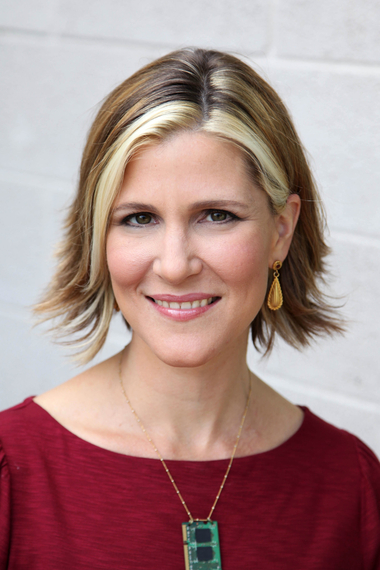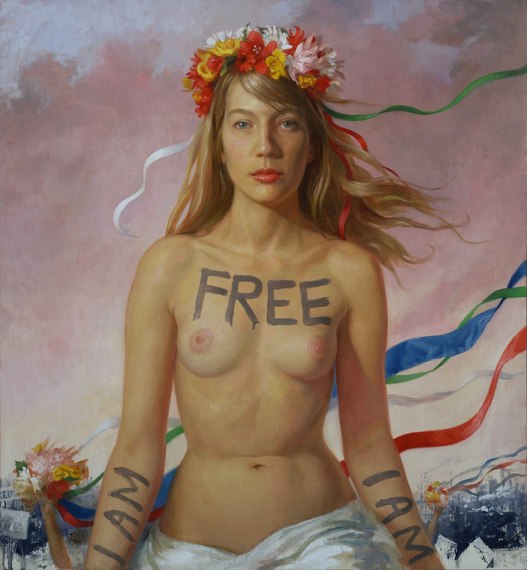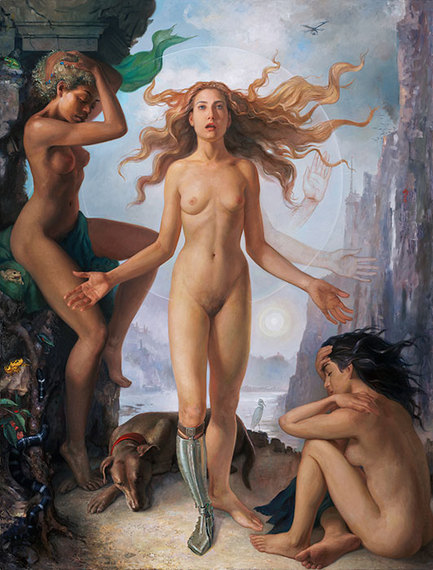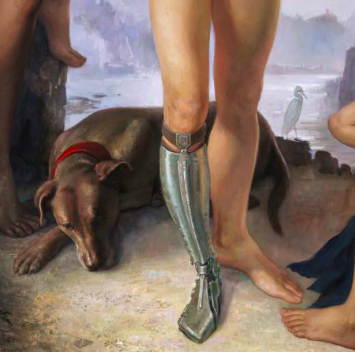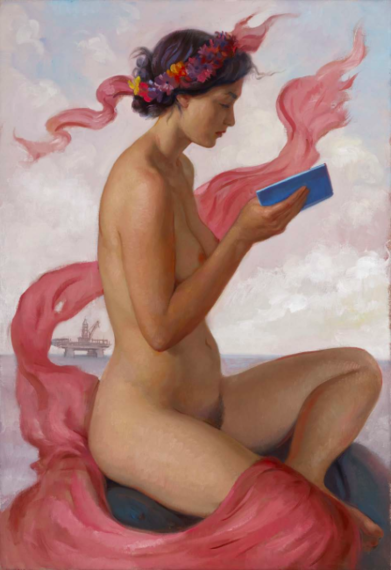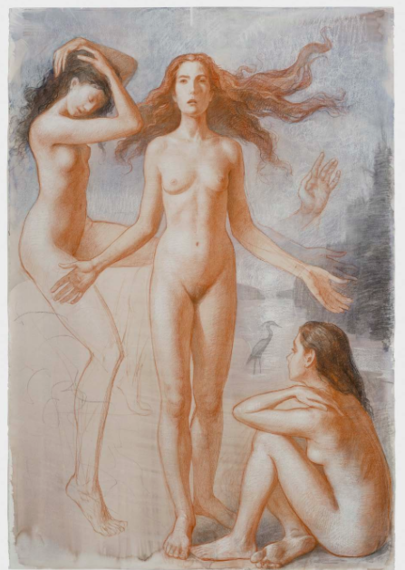Patricia Watwood's current show at Dacia Gallery--"New Narratives"--features two large multi-figure narrative paintings that have been developed over a period of two years. One of them, titled "Orpheus Playing for Persephone and Eurydice in the Underworld" tells the story of going to the ends of the earth for someone you love, arguing that music, art and human relationships are the things worth living for. The second painting, "The Sixth Extinction," highlights the vulnerability and crisis of our earth in the age of anxiety and climate change. The painting's female characters are allegorical figures--Gaia, the primordial earth goddess, a caryatid and a naiad--all drawn from the history of art and cast to symbolize humanity's precarious position.
Patricia Watwood
John Seed Interviews Patricia Watwood
Patricia, you have studied at the New York Academy and at two ateliers. When and how did you decide that you wanted to become a classically trained artist?
My interest in painting and becoming an artist specifically grew out of my exposure to classical and perceptually based art training. I had been working in theatre design, and began to draw and paint simply to develop my graphic skills. When I got into my first class that taught academic techniques, it exposed me to a whole world that I was previously unaware of. The training in observational and naturalistic drawing was the hook that completely drew me in. After doing a workshop with Anthony Ryder, I decided I wanted to get a classical training in an atelier. Other forms of painting and visual art had not been of interest prior to that introduction to contemporary figurative art.
Orpheus Playing for Persephone and Eurydice in the Underworld, 2013-2015
oil on canvas, 72 x 108 inches
What is Contemporary Classicism?
I have been in the habit of using "classical" in describing my work and training because I think that it conveys to the general public the same categorical idea as "classical music." If you tell someone you are a classical pianist at a cocktail party, they will have a quick general idea of your amount of training and kind of education. This is essentially the same in painting, though I appreciate that it's not as widely understood. I do also have a disposition toward classical design, as in considerations of composition, balance and subject matter. "Contemporary" is loaded in it's usage in art, but my use of it is simply to point toward the idea that I want my paintings to be understood as part of a current context and experience and not just a pastiche or nostalgia for other eras of painting.
Femen Flora, 2014, oil on linen, 28 x 26 inches
You have a particular interest in allegory. How did that come about?
I've always loved any art form or intellectual investigation into archetypes and myths. Writers like Joseph Campbell, Daniel Boorstin, and Kenneth Clark were early influences in thinking about universal narratives and the persistence of myth and story telling. My background in theatre exposed me to Homer, Aeschylus, Euripides, and Shakespeare and thinking about the universal truths in classic dramas. I'm also interested religion and sacred texts. All of these have in common their exploration of deep human emotion, and the desire to communicate our shared human experience through art.
I've always been most drawn to figurative art, and I think it's because of it's unique ability to convey spirit and shared emotion, and narratives over time. When I use an allegorical or mythical figure, I'm relying upon the cultural base of knowledge about general archetypes (like Venus, or Flora). Now that we have the internet in our pockets, it's easy to look up a character or reference, and that vehicle gives me a way to communicate my take on an a universal theme. I'm inviting viewers to slow down and look at the paintings and investigate the threads of meaning that I weave into the work.
The Sixth Extinction, 2015, oil on linen, 67 1⁄2 x 51 1⁄2" inches
Can you talk me through one of your recent allegorical paintings?
The painting that I most recently finished for my show at Dacia Gallery is called "The Sixth Extinction." The title is taken from a current scientific concept (and the book of the same name published in 2015) that is showing with a great deal of data that we are already underway in what is the sixth major mass extinction of species in the history of the earth: one other famous extinction caused the extinction of the large dinosaurs. The question for all of us is: Will we transform our society and way of living on the earth quickly enough to avoid a mass extinction that threatens human life? Climate change has already created large visible impacts for us in super storms, droughts and floods. This issue is the great challenge of our time, and I've been increasingly focused on it in my subjects.
In my painting, "The Sixth Extinction," the central figure is Gaia-- the personification of the Earth, and great mother of all. The two other figures are a caryatid-- an female figure symbolically bearing the weight of civilization, and a naiad- which is an allegory for water. The figures altogether represent earth and humanity's collective vulnerability. Also in the painting are some extinct and endangered snakes and frogs, a bird and a dog--representing how we are interconnected with our fellow species.
The Sixth Extinction (Detail)
Gaia is painted with a prosthetic robotic leg. On one hand, this is showing how we are not so perfectly ideal, but fragile and resilient. It's also a metaphor for how science and technology (like the amazing development in prosthetics) can be empowering and liberating. However, our proper relationship to science and technology will be the key to our continued success. I also added other symbols, like the multiple hands of Gaia that are reminiscent of the Hindu goddess Shakti: divine female creative energy and agent of change.
Pink Sybil, 2015, oil on linen, 20 x 14 inches
What are the major themes of your show at Dacia Gallery?
There's a new concept in ecology called "The Great Turning." It's an idea that our whole society is a the beginning of a paradigm shift away from late model capitalism to a sustainable culture that can live in balance with the planet. I'm very inspired by this concept, and want in my own way to contribute to it through art. With this show, I wanted to create a body of work that expresses both my feeling of vulnerability to our current world of change, and also points toward the human potential for hope and transformation.
In my drawings for the show, the women figures and the pictorial settings are all exploring our relationship to the world around us, and the figures are either bearing the burden, or becoming agents of change. The large narrative work "Orpheus Playing for Persephone and Euridice in the Underworld" has a imaginative landscape that is very similar in concept to "Sixth Extinction," but sunk in twilight. The theme of "Orpheus" is the power of beauty and emotion to be transformative, and is the story of going to the ends of the earth for the things you love in the world.
Fallen Caryatid I (snake), 2015
pencil, pastel, charcoal and watercolor on paper, 22 x 15 inches
You say that "Tradition has nothing to do with the past." Can you apply that to one of your recent works?
When I think of "tradition" in my field, I mean the total body of knowledge of painting lore and visual communication that is the lineage of figurative art. Figurative art is a living form, and even in the 20th century, had an unbroken pedagogy from masters to students that can be traced back to the Renaissance. Painting lore is not just technical knowledge but the vast body of understanding about the language and expression of visual art. Honoring the base of intellectual accomplishment of the ones who came before us, and continuing that body of knowledge is an important part of any successful society-- be it art, literature, science or medicine.
So, in "The Sixth Extinction," I'm using the traditional language allegory and characters you'll find in your art history book. However, the concept of "The Sixth Exctinction" is specifically a current societal concern. I'm using the traditional language of figurative art to make art that I hope points us toward the future.
Study for The Sixth Extinction, 2015
sanguine, charcoal and watercolor on paper, 44 x 30 inches
What are your interests outside of painting?
I have a family--I'm married, have two daughters, and a sprawling extended family-- so that's the greatest part of my life outside painting. I also love music, theatre and dance, and try to see performances regularly. I sing in a church choir, which is a joyful way for me to engage with making music and jump into emotional expression. The choir is great food for my soul, when I can engage in an art form that is not my "day job" but truly an "amateur". I'm an active member of my church community. I also love gardening and finding other ways to spend time outside-- camping, hiking, swimming, and maybe even some plein air painting!
Patricia Watwood: New Narratives
Dacia Gallery
53 Stanton Street, New York, NY 10002
Nov 18- Dec 12, 2015
daciagallery.com

